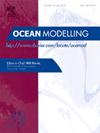寒潮和台风期间黄河口的波浪动力学
IF 2.9
3区 地球科学
Q2 METEOROLOGY & ATMOSPHERIC SCIENCES
引用次数: 0
摘要
黄河口位于半封闭的渤海海域,岸线复杂,水深浅,在极端天气条件下易受大浪影响。因此,采用双嵌套第三代波浪模型对台风“台风”(2021)和台风“台风”(2022)以及2021年和2022年两次寒潮事件的波浪动力学进行了研究。YRE模型经过改进以再现真实的高分辨率地形,然后根据四个长期浮标站的观测结果进行校准。结果表明,波浪特征与风密切相关,受局部测深调制。在寒潮期间,有效波高(Hs)的时间演变呈现双峰,而在台风期间,由于对风的替代发展响应,观测到单峰。这导致h和风之间有1.5小时的时间差。风浪主要主导海况,而巨浪则在台风通过后出现。深海折射在保护YRE南部地区免受遥远的能量膨胀方面起着至关重要的作用。进一步的研究表明,深度破碎和白浪共同控制着波浪的能量耗散。水深非均质性和浅滩化过程对波浪能量有很大影响,导致波浪衰减和空间变异性。强烈的三联波相互作用和破波有助于增加Hs,在传播过程中引起多次破波过程。YRE的发现有助于提高对类似的浅水巨型三角洲和河口波浪动力学的理解。本文章由计算机程序翻译,如有差异,请以英文原文为准。
Wave dynamics in the Yellow River Estuary during cold wave and typhoon events
The Yellow River Estuary (YRE), located in the semi-enclosed Bohai Sea, is characterized by complex shorelines and shallow water depths and is vulnerable to high waves during extreme weather events. Therefore, a dual-nested third-generation wave model was applied to investigate wave dynamics during Typhoons In-Fa (2021) and Mui-Fa (2022) and a pair of cold wave events in 2021 and 2022. The YRE model was refined to reproduce realistic high-resolution terrain and then calibrated against observations at four long-term buoy stations. Results indicate that wave characteristics closely correlate with winds, modulated by local bathymetry. During cold waves, the temporal evolution of the significant wave height (Hs) exhibits double peaks, whereas a single peak is observed during typhoons due to alternative development responses to winds. This resulted in a 1.5-h time lag between Hs and winds. Wind waves primarily dominate sea states, while swells occur after the typhoon passage. Bathymetric refraction plays an essential role in sheltering the southern region of the YRE from remotely energetic swells. Further investigations reveal that depth-induced breaking and whitecapping jointly control wave energy dissipation. Bathymetric heterogeneity and shoaling processes substantially influence wave energy, resulting in wave attenuation and spatial variability. Intense triad wave-wave interactions and wave breaking contribute to increased Hs, causing multiple wave-breaking processes during propagation. The findings in the YRE help enhance the understanding of wave dynamics in similar shallow-water mega deltas and estuaries.
求助全文
通过发布文献求助,成功后即可免费获取论文全文。
去求助
来源期刊

Ocean Modelling
地学-海洋学
CiteScore
5.50
自引率
9.40%
发文量
86
审稿时长
19.6 weeks
期刊介绍:
The main objective of Ocean Modelling is to provide rapid communication between those interested in ocean modelling, whether through direct observation, or through analytical, numerical or laboratory models, and including interactions between physical and biogeochemical or biological phenomena. Because of the intimate links between ocean and atmosphere, involvement of scientists interested in influences of either medium on the other is welcome. The journal has a wide scope and includes ocean-atmosphere interaction in various forms as well as pure ocean results. In addition to primary peer-reviewed papers, the journal provides review papers, preliminary communications, and discussions.
 求助内容:
求助内容: 应助结果提醒方式:
应助结果提醒方式:


